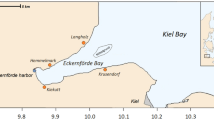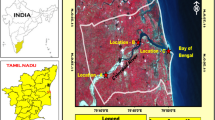Abstract
The Yeongsan River estuary (YRE) is located downstream of a dam housing an artificial lake on the southwestern coast of Korea. Intermittent discharges of lake water through dam gates control the water level of the lake. This study compares fluxes of dissolved nutrients in discharged water with those of submarine groundwater discharge (SGD) occurring in the YRE in July and October 2008. With the exception of dissolved inorganic phosphorus (DIP) which limits primary production, nutrient concentrations in the YRE are controlled mainly by conservative mixing between lake water and open ocean water during periods of lake water discharge. In comparison with lake water discharge, the magnitude of SGD, based on a 222Rn mass balance model, is relatively small (about 1.5×105 m3 day−1 in July and about 30% higher in October) and dependent on the water elevation in the lake. However, SGD contributes considerably to the input of DIP when discharge of lake water is halted. Our study shows that SGD is more important in the delivery of biogeochemical components into estuaries that are obstructed by artificial dams.
Similar content being viewed by others
References
Burnett WC, Taniguchi M, Oberdorfer J (2001) Measurement and significance of the direct discharge of groundwater into the coastal zone. J Sea Res 46:109–116
Burnett WC, Dulaiova H (2003) Estimating the dynamics of groundwater input into the coastal zone via continuous radon-222 measurements. J Environ Radioactivity 69:21–35
Cho YG, Park KY (1998) Heavy metals in surface sediments of the Youngsan estuary, West Coast of Korea. J Korean Environ Sci 7:549–557
Church TM (1996) An underground route for the water cycle. Nature 380:579–580
Diaz RJ, Rosenberg R (2008) Spreading dead zones and consequences for marine ecosystems. Science 321:926–929
Dulaiova H, Peterson R, Burnett WC, Lane-Smith D (2005) A multi-detector continuous monitor for assessment of 222Rn in the coastal ocean. J Radioanal Nucl Chem 263:361–365
Hong SJ, Lee DI, Kim DM, Park CK (2000) Material budgets in the Nakdong River estuary with simple box model. J Korean Soc Mar Environ Eng 3:50–57
Hwang DW (2005) Magnitudes and mechanisms of submarine groundwater discharge (SGD) in the South Sea of Korea. Ph.D. Thesis, Pukyong Natl Univ, 186 p
Hwang DW, Lee YW, Kim G (2005) Large submarine groundwater discharge (SGD) and benthic eutrophication in Bangdu Bay on volcanic Jeju Island, Korea. Limnol Oceanogr 50:1393–1403
ICOLD (1998) ICOLD world register of dams, computer database. International Commission on Large Dams, Paris
Kim G, Ryu JW, Hwang DW (2008) Radium tracing of submarine groundwater discharge (SGD) and associated nutrient fluxes in a highly-permeable bed coastal zone, Korea. Mar Chem 109:307–317
Kim GS (1999) A numerical simulation of M2 tide in Mokpo Harbour. Mokpo National Maritime Univ Press, Mokpo, 97 p
Kim YG (2007) Sedimentary characteristics and bathymetric changes of the Youngsan River estuary, southwestern coast of Korea. M.S. Thesis, Mokpo Natl Univ, Mokpo, 78 p
Kwon JN, Kim JG, Ko TS (2001) The estimation of water quality changes in the Keum River estuary by the dyke gate operation using long-term data. J Korean Fish Soc 34(4):348–354
LaRoche J, Nuzzi R, Waters R, Wyman K, Falkowski P, Wallace D (1997) Brown tide blooms in Long Island’s coastal waters linked to interannual variability in groundwater flow. Glob Change Biol 3:397–410
Lee NI, Kim GS (2003) Estimation of pollution loads flowing into Mokpo Harbour-Centering on pollution loads from land in dry case. J Korean Soc Mar Environ Eng 6:11–20
Lee YW, Hwang DW, Kim G, Lee WC, Oh HT (2009) Nutrient inputs from submarine groundwater discharge (SGD) in Masan Bay, an embayment surrounded by heavily industrialized cities, Korea. Sci Total Environ 407:3181–3188
MacIntyre S, Wanninkhof R, Chanton JP (1995) Trace gas exchange across the air-water interface in freshwater and coastal marine environments. In: Matson PA, Harriss RC (ed) Biogenic Trace Gases: measuring emissions from soil and water, Blackwell, Cambridge, Massachusetts, pp 52–97
Sanford LP, Boicourt WC, Rives SR (1992) Model for estimating tidal flushing of small embayments. J Waterway Port Coast Ocean Eng 118:635–654
Stieglitz T (2005) Submarine groundwater discharge into the near-shore zone of the Great Barrier Reef, Australia. Mar Pollut Bull 51:51–59
Taniguchi M, Burnett WC, Cable JE, Turner JV (2002) Investigation of submarine groundwater discharge. Hydrol Proc 16:2115–2129
Weigel VF (1978) Radon. Chemiker Zeitung 102:287
Yang HS, Hwang DW, Kim G (2002) Factors controlling excess radium in the Nakdong River estuary, Korea: submarine groundwater discharge versus desorption from riverine particles. Mar Chem 78:1–8
Author information
Authors and Affiliations
Corresponding author
Rights and permissions
About this article
Cite this article
Kim, J., Kim, JS. & Kim, G. Nutrient input from submarine groundwater discharge versus intermittent river-water discharge through an artificial dam in the Yeongsan River estuary, Korea. Ocean Sci. J. 45, 179–186 (2010). https://doi.org/10.1007/s12601-010-0016-1
Received:
Revised:
Accepted:
Published:
Issue Date:
DOI: https://doi.org/10.1007/s12601-010-0016-1




